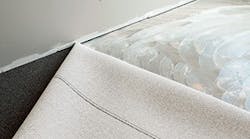VOCs can lurk in virtually every corner of your building, but you may have overlooked a source right underneath your feet – carpet adhesives. These glues can emit toxic chemicals that cause more than an annoying odor. To avoid IAQ issues, choose water-based adhesives, products that carry the Green Label Plus certification or glue-free systems. The right choice is the safe choice.
Green Label Plus
As there are no industry flooring standards that mandate VOC levels, look for third-party certifications. Offered by the Carpet and Rug Institute (CRI) and accredited by ANSI, Green Label Plus measures and limits VOC emissions for carpet, adhesive and cushion products. Created in 1992, the label is so widely used that “95% of carpet meets the Green Label Plus program’s thresholds for VOCs,” says Paul Tucker, CRI Communications Coordinator.
This voluntary certification is recognized by ASHRAE 189.1, the International Green Construction Code and CalGreen. Green Label Plus-certified products may also contribute one point for low-emitting materials under LEED v4, adds Tucker.
Tested by an independent laboratory with protocols developed by the EPA and ASTM, the screening looks for 35 compounds identified in California’s Section 01350, including chloroform, ethylene glycol, formaldehyde, styrene and toluene. It also evaluates seven components specific to adhesives, such as benzothiazole, methyl biphenyl and vinyl cyclohexene. All of these chemicals have been documented by the CDC and various medical studies as potential carcinogens, neurotoxins, endocrine disruptors and teratogens (which cause birth defects).
Products must pass a 14-day test window to ensure released compounds are below specified total VOC (TVOC) levels and yearly retesting is also required. Major brands such as Mannington, Beaulieu, Roppe, Forbo, Gerflor, Mohawk, Shaw, Tandus, Milliken, Bentley Mills and Tarkett all have certified adhesives.
Eco-Friendly Alternatives
In the absence of an eco-label, specify water-based adhesives. Solvent-based formulas contain a number of polymers that are typically the culprit of VOC emissions. The water-based versions also tend to cure faster and can be safer for workers to handle.
If a health or environmental product declaration is available, look for TVOC by volume. You can use the limit specified in the LEED IEQ credit for adhesives and sealants as a benchmark: 50 grams per liter or 0.4 pounds per gallon. You can also request products that are tested per ASTM D2369 or D6886-03 or ISO 11890.
Even though the risk is low that inhaling adhesive fumes could result in serious complications, short-term exposure can cause headaches, nausea and irritation to respiratory tissues. These can decrease concentration and ultimately lower productivity. Relocate employees from the area and use ventilation to significantly dissipate obtrusive odors and lingering VOCs.
“New broadloom carpet should be aired out for 24 hours. Lay it out the night before installation so it has time to relax and acclimate to your building,” recommends Lew Migliore, President of the consulting firm LGM and Associates.
Glue-Free Options
If you want to skip adhesives altogether, there are several products that are installed without glues.
TacTiles by Interface and TileTabs from J+J Flooring Group use adhesive squares that connect to the backing to create a floating floor. This method protects the subfloor from damage as well. There are also several manufacturers that offer peel-and-stick tiles. TacFast Systems uses a releasable hook-and-loop attachment substrate that is similar to VELCRO.
These options are faster to install because there’s no drying time and spaces can remain occupied during installation. Facility managers can also rearrange and replace tiles with ease.
Occupants can spend over 40 hours a week in your building and deserve an indoor environment that doesn’t create health risks. Skip the buckets of glue and use adhesives that keep your indoor air fresh and clean.
Jennie Morton is a contributing editor for BUILDINGS.


